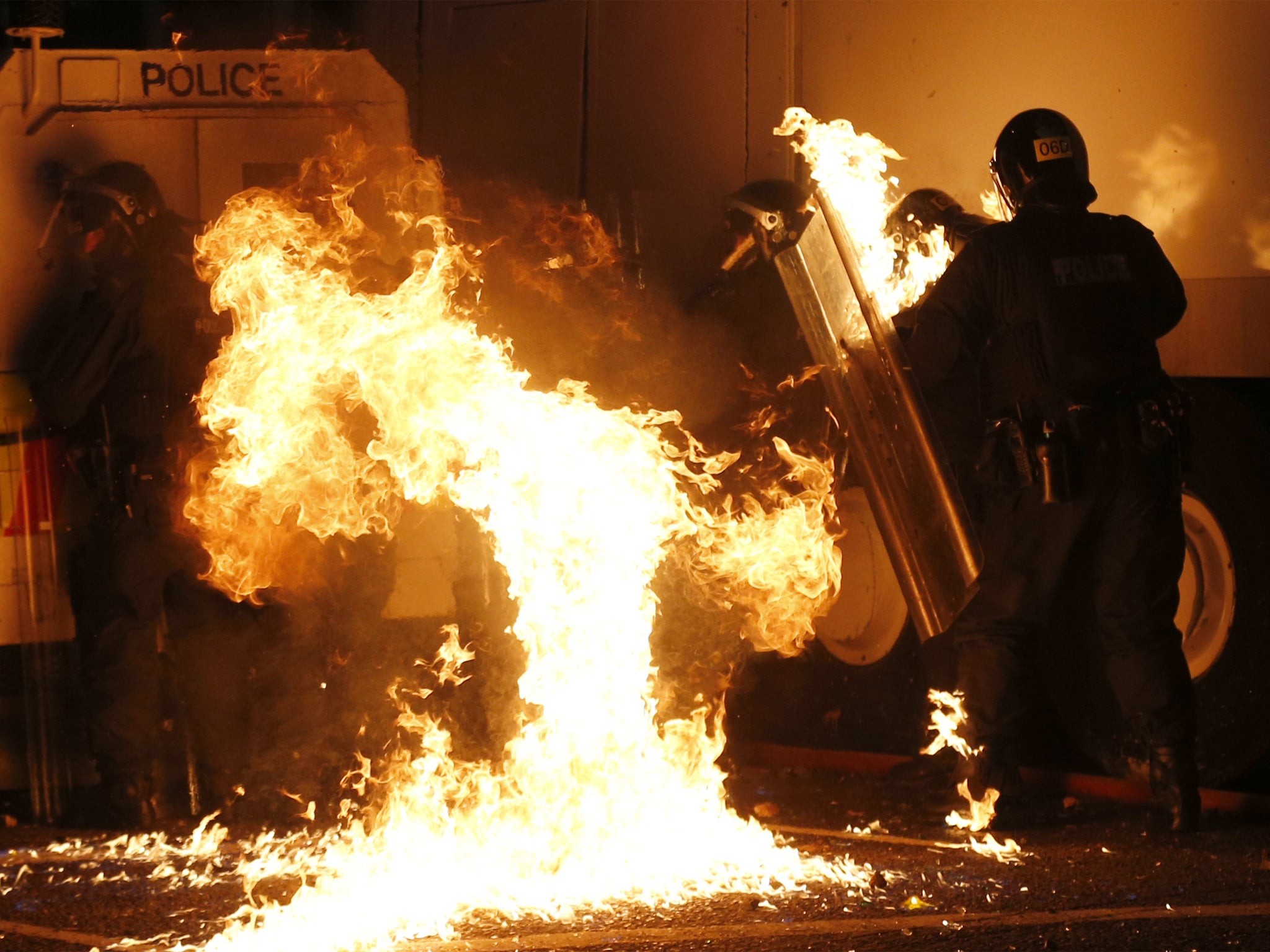Belfast riots: US diplomat arrives to resolve thorny issues as petrol bombs and missiles injure police
‘Peace envoy’ to Northern Ireland appointed in a bid to resolve issue of contentious parades

A senior US diplomatic figure will arrive in Belfast this week with a mission to resolve thorny issues such as the recurring rioting which has just caused dozens of injuries to police.
In the wake of the riots, former State Department official Richard Haass will chair all-party talks on issues including controversial parades, the flying of flags and how to deal with the past.
The most urgent topic will be that of marches, which this week led to clashes leaving 71 police injured, mostly from encounters with loyalists. Several nights of disturbances have illustrated that Northern Ireland’s peace process has a long way to go.
The disorder has cost millions of pounds, and a number of incidents have shown that sectarian hatred continues to run at a high level in some working-class districts.
The starkest illustration came in west Belfast where a statue of the Virgin Mary was taken from a Catholic church, defaced, and placed on an unlit loyalist bonfire. A priest, however, thanked another Protestant who retrieved the statue and returned it.
In a separate incident, an effigy of a popular priest who recently died was placed on top of a bonfire.
Although the violence was slightly diminished this year, its recurrence demonstrated that the July peak of the Loyalist marching season continues to almost always result in street disturbances, including rioting and petrol bomb attacks.
This year most of the violence was directed at police by loyalists who objected to a ban on the Orange Order marching past the Catholic Ardoyne area of north Belfast. The subsequent rioting saw loyalists pelting police with bricks and other missiles, and cheering when an officer was knocked to the ground. The rioting seemed to be a mixture of political and sectarian anger, with a near-carnival atmosphere and much alcohol involved.
Nigel Dodds, a Democratic Unionist Party MP, was said to be recovering well after he was knocked unconscious by a brick apparently thrown at police by a loyalist. Police branded the Orange Order reckless in encouraging protests, though the organisation later called for the suspension of the demonstrations after the injury toll mounted. According to Assistant Chief Constable Will Kerr: “There is a volatility out there that’s very obvious to the people who have been on the streets of north Belfast. If you bring people out on to the streets you need to have calm and control, and we didn’t see either of those things.
“The behaviour of some was animalistic. Our officers acted with extreme professionalism in the face of violence. Some of these attacks can only be seen as attempted murder on officers.”
Dozens of men and youths have already been charged by police, with hundreds of more expected to be charged later. Meanwhile, in a number of incidents, dissident republicans threw ineffective bombs at police.
In the familiar blame game that followed, much condemnation was directed at the Orange Order. The Justice minister, David Ford, said: “The Orange Order must show some leadership and use any influence they have to prevent more trouble. So far, some of the language used by individuals and groups undoubtedly contributed to the situation which led to some people rioting.”
The order disclaimed responsibility for outbreaks, insisting it had been consistent and unambiguous that violence had no place in protests. Most immediately, the hope is that, as in previous years, the trouble will peter out after a few days. But the assumption is that next year will bring similar scenes unless new agreed measures on contentious parades are put in place within the next 12 months.
The invitation to Mr Haass to chair talks as a “peace envoy” is an attempt to achieve a breakthrough on an issue which, despite numerous attempts, has proved beyond the abilities of Belfast politicians to resolve. His task will not end there, since he is also being asked to tackle issues such as the flying of flags, which led to months of disruptive protests earlier this year.
Also on his agenda will be exploring whether a “truth and reconciliation commission” could help move the peace process on. This is another daunting task, given that more than a decade of local efforts have failed to achieve even limited progress.
Peace envoy: The coming man
Richard Haass will arrive in Northern Ireland with two initial advantages. The first is that he knows the Belfast scene well, having spent two years as President George W. Bush’s envoy from 2001 to 2003.
The second is that he has much experience in conflict resolution, first as a senior diplomat and later as president of the Council on Foreign Relations. One of his dozen books may have particular relevance - “How to be effective in any unruly organisation.”
Sinn Fein deputy first minister Martin McGuinness said of him: “We are not talking about a rookie coming in. He knows everybody. He’s somebody who made huge efforts here. He knows the intricacies and complexities.”
One of his predecessors as peace envoy, former US Senator George Mitchell, is regarded as one of the heroes of the peace process who helped bring once-warring elements together.
Subscribe to Independent Premium to bookmark this article
Want to bookmark your favourite articles and stories to read or reference later? Start your Independent Premium subscription today.

Join our commenting forum
Join thought-provoking conversations, follow other Independent readers and see their replies